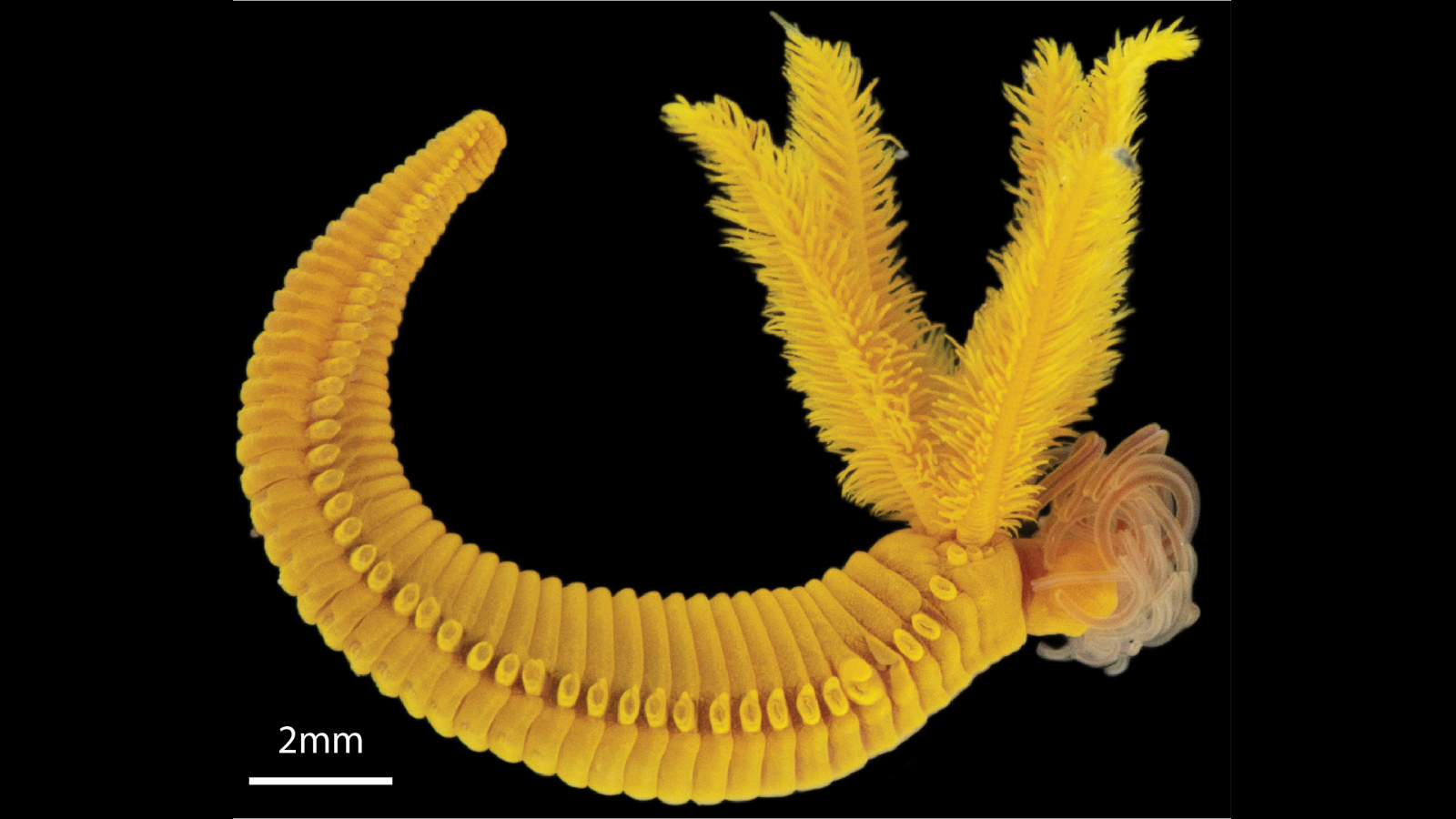By Lydia Smith
Copyright livescience

Skip to main content
Close main menu
Live Science
Sign up to our newsletter
View Profile
Search Live Science
Planet Earth
Archaeology
Physics & Math
Human Behavior
Science news
Life’s Little Mysteries
Science quizzes
Newsletters
Story archive
Lab brains could become conscious
Jaguar smashes swim record
Mysterious hand positions on Maya alter
It’s too late to stop AI, readers say
Anthropologist Ella Al-Shamahi on human origins
Don’t miss these
Headless chicken monster: The deep sea cucumber with tubular feet for gobbling sediment
Never-before-seen adorable pink bumpy snailfish with funny little beard filmed in deep canyon off California coast
Rivers & Oceans
Chinese submersible explores previously unknown giant craters at the bottom of the Pacific — and they’re teeming with life
Scientists are finally learning what’s inside mysterious ‘halo’ barrels submerged off Los Angeles
Dwarf sperm whale: The ‘pint-size whales’ that gush gallons of intestinal fluid when surprised
Land Mammals
Aye-ayes: The strange nocturnal lemurs with long, creepy fingers
‘Big-butt starfish,’ ‘little sweet potato’ and dozens of never-before-seen species recorded during deep-sea expedition off Argentina
A mysterious barrier in the Atlantic divides weird deep-sea jellyfish cousins
Mystery of why sea stars keep turning into goo finally solved — and it’s not what scientists thought
Why is the blue-ringed octopus so deadly?
Microbiology
Embattled ‘arsenic life’ paper retracted by journal Science 15 years after publication
Fishers discover first-of-its-kind bright orange shark with two rare conditions in Caribbean
Our gut bacteria can absorb and remove toxic ‘forever chemicals’ — at least in lab mice
Creepy new giant insect may be the heaviest ever recorded in Australia
Extinct species
‘Most remarkable’ fossil of Jurassic sea monster from Germany is previously unknown species
Paralvinella hessleri: The yellow worm that lives in acid and fights poison with poison
Lydia Smith
20 September 2025
These deep-sea worms, which are 1% arsenic, are only found at the hottest hydrothermal vents in the western Pacific.
When you purchase through links on our site, we may earn an affiliate commission. Here’s how it works.
The worm Paralvinella hesslerihas a bright yellow color from storing arsenic in its skin cells, where the toxin reacts with sulfide from vent fluids to form orpiment — a orange/yellow pigment.
(Image credit: Wang H, et al., 2025, PLOS Biology, CC-BY 4.0 (https://creativecommons.org/licenses/by/4.0/))
QUICK FACTS
Name: Paralvinella hessleri
Where it lives: Pacific Ocean
What it eats: Bacteria and organic debris around hydrothermal vents
Deep-sea creatures are uniquely adapted to living in extreme environments, and the worm Paralvinella hessleri is no exception. In fact, it survives high levels of toxic chemicals like arsenic by creating its own poison.
P. hessleri is a member of the family Alvinellidae, a group of small tube worms adapted to some of the most extreme environments on Earth.
Found only at the hottest hydrothermal vents in the western Pacific, including the Okinawa Trough and Mariana Back-Arc Basin, these worms grow up to about 0.8 inches (22 millimeters) in length and live in protective tubes attached to vent chimneys. Remarkably, P. hessleri is the only known animal able to colonize and thrive in the acidic, metal-rich zones of these vents, where temperatures can reach around 608 degrees Fahrenheit (320 degrees Celsius).
You may like
Headless chicken monster: The deep sea cucumber with tubular feet for gobbling sediment
Never-before-seen adorable pink bumpy snailfish with funny little beard filmed in deep canyon off California coast
Chinese submersible explores previously unknown giant craters at the bottom of the Pacific — and they’re teeming with life
These worms have an unusual survival trick that lets them withstand the high levels of toxic arsenic and sulfide found at hydrothermal vents. In humans, arsenic exposure is linked to serious health problems, including cancer and neurological disorders. P. hessleri, however, turns this danger into a defense: it stores arsenic in its skin cells, where the toxin reacts with sulfide from vent fluids to form orpiment — a less harmful, though still poisonous, mineral.
This bright yellow-orange substance, once known as “King’s Yellow,” was historically used by artists as a pigment until its toxicity became clear. P. hessleri, which has a yellow-orange tint due to the orpiment crystals, can accumulate so much arsenic that it makes up nearly 1% of the worm’s body weight.
RELATED STORIES
—First-of-its-kind footage captures bizarre sea creatures flourishing in extreme depths of the ocean
—Strange corkscrew burrows and other unexpected structures discovered 4.7 miles deep in the Japan Trench
—Ghostly white giant worms appear to be reproducing under the seafloor where tectonic plates meet
In a 2025 paper published in the journal PLOS Biology, the researchers who discovered the worms’ survival strategy described the process as “fighting poison with poison.”
Commenting on the discovery, study co-author Hao Wang, a researcher at the Chinese Academy of Sciences’ Institute of Oceanology, said he was “stunned” when he first saw the worms with a remotely operated vehicle.
Sign up for the Live Science daily newsletter now
Get the world’s most fascinating discoveries delivered straight to your inbox.
Contact me with news and offers from other Future brandsReceive email from us on behalf of our trusted partners or sponsorsBy submitting your information you agree to the Terms & Conditions and Privacy Policy and are aged 16 or over.
“The bright yellow Paralvinella hessleri worms were unlike anything I had ever seen, standing out vividly against the white biofilm and dark hydrothermal vent landscape,” he said in a statement. “It was hard to believe that any animal could survive, let alone thrive, in such an extreme and toxic environment.”
amazing animals
Lydia Smith
Social Links Navigation
Science Writer
Lydia Smith is a health and science journalist who works for U.K. and U.S. publications. She is studying for an MSc in psychology at the University of Glasgow and has an MA in English literature from King’s College London.
You must confirm your public display name before commenting
Please logout and then login again, you will then be prompted to enter your display name.
Headless chicken monster: The deep sea cucumber with tubular feet for gobbling sediment
Never-before-seen adorable pink bumpy snailfish with funny little beard filmed in deep canyon off California coast
Chinese submersible explores previously unknown giant craters at the bottom of the Pacific — and they’re teeming with life
Scientists are finally learning what’s inside mysterious ‘halo’ barrels submerged off Los Angeles
Dwarf sperm whale: The ‘pint-size whales’ that gush gallons of intestinal fluid when surprised
Aye-ayes: The strange nocturnal lemurs with long, creepy fingers
Latest in Animals
Cold snap in Florida made Burmese python puke up a whole deer
Jaguar in Brazil smashes record for the species’ longest documented swim
Oldest-known dome-headed dinosaur discovered sticking out of a cliff in Mongolia’s Gobi Desert
‘Rare’ ancestor reveals how huge flightless birds made it to faraway lands
Grumpy-looking Pallas’s cat photographed by camera trap in stunning photo from eastern Himalayas
‘Almost like science fiction’: European ant is the first known animal to clone members of another species
Latest in Features
Paralvinella hessleri: The yellow worm that lives in acid and fights poison with poison
Why does Pluto have such a weird orbit?
What are the ‘magic numbers’ in nuclear physics?
‘Like trying to see fog in the dark’: How strange pulses of energy are helping scientists build the ultimate map of the universe
A tragic gene therapy death that stalled the field for a decade — Sept. 17, 1999
Science history: Gravitational waves detected, proving Einstein right — Sept. 14, 2015
LATEST ARTICLES
Why does Pluto have such a weird orbit?
Science news this week: The world’s oldest mummy, and an ant that mates with clones of a distant species
Who is eligible for this year’s COVID vaccine? Everything you need to know
Ötzi quiz: What do you know about the Iceman mummy who was murdered 5,300 years ago in the Alps?
Why does your breath sometimes stink even after brushing your teeth?
Live Science is part of Future US Inc, an international media group and leading digital publisher. Visit our corporate site.
Contact Future’s experts
Terms and conditions
Privacy policy
Cookies policy
Accessibility Statement
Advertise with us
Web notifications
Editorial standards
How to pitch a story to us
Future US, Inc. Full 7th Floor, 130 West 42nd Street,
Please login or signup to comment
Please wait…



